#anti-immigrant sentiment (not mine
Explore tagged Tumblr posts
Text
Xenophobia in Celtic nations' independence movements: A guide to the red flags
This is something I've wanted to write about for a long time - I want to go over this in more detail when I can. But for now a short guide to the most egregious red flags is warranted imo.
'Celtic nations' refers to the modern regions where Celtic languages are still spoken, namely Ireland, Wales, Scotland, Isle of Man, Cornwall and Brittany. Its important to know that these places are called Celtic not because of who lives there, but because of the languages which have survived there. Its a common error to think 'Celtic nations'= Celtic people. In my field (Celtic Studies) Celtic is generally only applied as a descriptor in the sense of language family.
Because of the popular misinformation 'Celtic nation' = 'Celtic' population, xenophobia rears its ugly head in multiple corners of the various Celtic nations' independence movements. Left unchecked, this xenophobia develops into outright racism. Which is why it's important to recognise these red flags when you see them.
'Acceptable Targets':
The reason why some of the xenophobia goes unchecked (and develops into worse kinds) is because a lot of xenophobia in the Celtic nations is aimed at 'acceptable' targets - which no-one bats an eye about when this rhetoric is deployed. But were it deployed against any other nationalities, it would immediately obvious that it isn't acceptable. Now, I will preface this with that there's nuance with these nationalities and there's something to be said about whether some of it is 'punching up'. However, because of how accepted it is to be casually xenophobic against these privileged groups, it is signalled through that that it's okay to be xenophobic in general to less privileged groups. I feel its important to address the first rung on the ladder before tackling any higher up.
Without beating around the bush, I'm talking about the English (and French. But I know more about the English so that's where my focus will be).
Yes, pro-independence anti-English memes and jokes can be funny. Most of them do stay on the side of punching up and many raise important points on the effects of English imperialism on the Celtic languages. However, there's a fine line between punching up and voluntarily using and wielding xenophobic arguments and rhetoric to get one up on the English. This, in my view, only paves the way for worse kinds of xenophobia and to me is a canary in the coal mine situation. But I also cannot talk about this without also making it clear that it is possible to recognise that sometimes a line is crossed without validating English persecution complexes à la 'you can't even say you're English these days' or similar nonsense. Both things can be true at once: Casual xenophobia against the English does exist, however, its existence should not be used to validate English persecution complexes. On the contrary, we should fight that also.
The reason why this canary in the coal mine has gone unnoticed is because of the reluctance to actually point out xenophobia against the English in pro-independence movements due to fear of accidentally validating the claims Englishness as a concept is under threat or due of fear of ostracism from Celtic nationalist movements. There is little danger of actually validating the former sentiment, however, because of a crucial fact. The people in the Celtic nations being casually xenophobic and the English with persecution complexes have one massive trait in common: they're both xenophobic in incredibly similar ways. If it's hard to tell apart an English nationalist from one in a Celtic nation if you were to swap the target of their ire, congratulations, your movement has a xenophobia problem /s.
English nationalist: We should tighten controls on our borders to keep all those foreigners and immigrants out. Make England English again.
(Xenophobic) Celtic nationalist: We should fight for our independence so we can tighten controls on our borders to keep all those foreigners and immigrants out. Make [insert Celtic nation] [nationish] again.
Many Celtic nationalists will also present ahistorical facts or manipulated versions of history in order to seem more valid or legitimate. It's a massive red flag when someone's grasp of history seems more emotional than grounded in historical fact. Using Welsh history as an example, I've seen this type of Celtic nationalist blatantly lie about historical figures, literally deface ancient castles in Wales based on a poor grasp (and respect for) history and conflate modern English and Welsh identity with ancient entities which do not map neatly 1:1. The ahistory presented by individuals or groups fancying themselves as leaders in their respective movements are unquestioningly accepted by others in the Celtic nationalist movements. This creates a manufactured mythology, belief in which confers in-group status and out-group status. A mythology which reinforces beliefs already present in the movement - such as the right to be casually xenophobic as long as it's against the 'right people' and as long as it is done in the name of protecting or advocating for their nation.
It was never going to stop at English people:
Once casual xenophobia is established as being tolerated, expected or even encouraged in the various independence movements, it enables xenophobes to be bolder in their rhetoric. Because casual xenophobia against 'deserving' nations like England is dismissed as 'just banter' and not taken seriously, it sends a signal to everyone in that movement that xenophobia is okay if its used against the 'right groups. While it may roll like water off a duck's back to the average English person, other, more vulnerable people do not fare so well.
To use an actual example I've seen out in the wild, some people will claim that you can't be considered Welsh unless you were born in Wales. Many people won't question this or interrogate the implications. Firstly, this comes back to how Celtic nationalists can often sound exactly the same as English nationalists (blood and soil nationalism is common to English and Celtic nationalisms). Secondly, this rhetoric also simulataneously invalidates several ostensibly Welsh people, such as Saunders Lewis (born in Liverpool) and Jan Morris (born in Somerset). In most cases, anyone who lives in X country / is a citizen of X country can or should be able to describe themselves as Xish.
The perennial anxiety of Celtic nationalists is that because most of the Celtic nations (excepting the Republic of Ireland) are constituent parts of a state (either the UK or France) and not independent entities in their own right, there is no control over borders and there is no system by which someone can be made a Welsh, or Breton or Cornish etc. citizen - and thus no way to control [nation]ness via those means. When Celtic nationalists agitate for independence, it's important to interrogate their motivations. If they are motivated primarily by a desire to control who is considered Xish and who isn't, that's a red flag.
English nationalists have this citizenship problem too, since England is not an independent nation, but a country within the UK. However, most English nationalists overlap heavily with British nationalists in general, so most agitation for 'sovereignty' gets channelled into British nationalism. This is one of the key differences between English and Celtic nationalists - the former is usually very fond of the United Kingdom, the latter detests it and wants to secede. This leaves Celtic nationalism in a tight spot - there is a desire for self determination which is currently impossible to achieve or enforce. And that makes a lot of Celtic nationalists anxious. And that anxiety leads to feeling like they need to prove their commitment to the cause by performing xenophobia, which validates their in-group status while simultaneously establishes the out-group.
A person born in England but who lives in Wales, perhaps speaks Welsh or considers themself Welsh will, in general, be mostly unharmed by 'you have to be born in Wales to be Welsh' rhetoric. But you know who might be? So many immigrants who consider themselves Welsh who make Wales a great place to be. Immigrants in Wales (especially nonwhite immigrants) may feel excluded by such rhetoric. It's almost on par with "where are you really from" sentiments. And this is an entirely self-defeating kind of rhetoric for Celtic nationalists to take up. Here we have thousands upon thousands of people who willingly want to live and work in Celtic nations - many of whom will also learn the language - undoing centuries of English and French propaganda that diminished the worth of Celtic nations and their languages* - and Celtic nationalists want to exclude these people from claiming the nationality of their adopted nations because... they didn't happen to be born here. Got it.
Xenophobia, once established, cannot be contained:
Xenophobia ripples outwards. Once it is established it is okay to be xenophobic to certain groups, other groups begin to be included in the xenophobia. This then has the potential to expand into outright racism. In Ireland, for example, there's significant amounts of antiblack racism present in the nationalist movement. Very recently, due to the actions of the UK government over the Rwanda Plan, the Republic of Ireland has gotten frustrated at the amount of immigrants attempting to reach their shores after abandoning attempts to claim asylum in the UK (out of fear of being sent to Rwanda). There's a "we don't do that here" attitude in many Celtic nationalist movements with regards to English imperialism, xenophobia, racism and anti-immigration. But not only do we do that here - it's worryingly integral to some people's visions for their nation's independence! You end up with complacency because many will take a literal no true Scotsman approach to Celtic nationalism and pretend that such people aren't really part of the movement. The problem is, is that they are here and regularly hijack otherwise unproblematic movements.
There are many routes through which Celtic nationalists can get radicalised into becoming massively xenophobic in order to fight for their respective nation's independence. All of them stem from real, legitimate problems in each nation whose cause has been misidentified.
One way is through opposition to second homes. On all counts, a noble goal and a very legitimate problem which I myself am invested in fighting. But the ways in which this problem is addressed often veer into questionable territory. If the focus is on "how dare those people from over there come over here" instead of "how dare a very small group of people monopolise housing for holiday lets at the expense of locals" there's a problem. The problem isn't people not from [place] holidaying there, it's the people who monopolise housing for their own profit which reduces housing available for locals and destroys community. In Aberystwyth I've heard some appalling sentiments against people from the Midlands - borderline if not outright classism around their appearances, mannerisms and accents. Sneering at random families visiting the beach isn't going to help anything and only exposes thinly veiled bigotry in whoever is making such remarks.
As already mentioned, another way radicalisation into xenophobic Celtic nationalism can occur is through mythologised 'history' which has been manipulated to suit the needs of the person or people making the claim. Lately, I've been seeing a rise in Welsh 'history' groups rife with disinformation and outright misrepresentation of historical events which are so designed to keep people angry about historical injustices against Wales. There are plenty of real historical injustices which can be talked about - but the 'history' presented in these groups is often fabricated or twisted to make things worse than they were or are stripped of nuance which perhaps paints certain historical figures less favourably than the authors would have liked. Not to mention superimposing modern nationalism onto ancient peoples is also just accepted as fine to do. Here is a screenshot of a Welsh 'history' group shared in a Welsh learning group I'm in. I can and will do a deeper dive into this topic in particular when I can. For now I'll mention the most important things to notice:
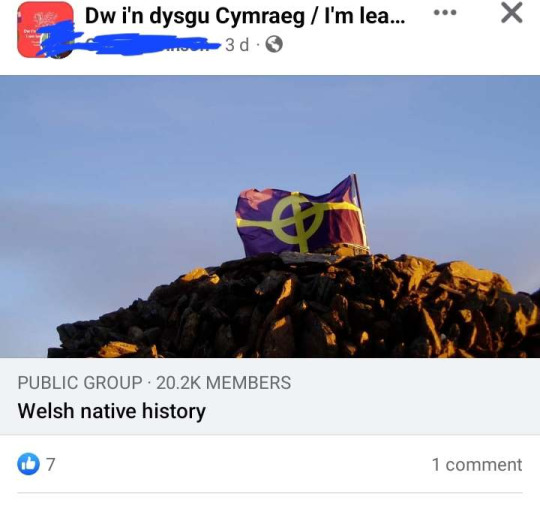
As mentioned in one of my other posts on this topic - the term 'native' is frequently misused in a Celtic context. Here, it sets up the basic in-group/out-group dynamic from the start and creates a setting in which members of the group are privy to the 'real' history while others are not. A brief glance at posts in this group makes that quite clear. The flag in the image is a representation of Y Groes Naid - supposedly a piece of the True Cross kept at Aberconwy. Now, there are ways to depict this cross which aren't so dogwhistley - so I'm immediately suspicious this image was chosen on purpose. Right down to the fact there's plausible deniability if anyone tries to point out how much the flag looks like the white supremacist Celtic Cross symbol, since it's Y Groes Naid, right?
I will wrap this up with that as a Celticist, I see far too many people uncritically supporting certain Celtic nationalist movements simply because they are pro-independence. Turning a blind eye to 'acceptable' xenophobia and choosing to believe ahistorical versions of history because it better suits their politics. This must be resisted - we can advocate for the independence of Celtic nations which desire it without relying upon these means. It can be done, I promise. But the path to that means dismantling systems of oppression which exist within Celtic nationalist movements. Awareness of the problem in the first place is a good place to start.
Reblogs and comments are welcome on this post to raise awareness of the issue and actually talk about these things.
Diolch am darllen!
#cymblr#tymblr#Celtic#celtic studies#celtic languages#celtic nations#racism cw#(in case)#xenophobia#anti xenophobia#antiracism#celtic history#celtic mythology#welsh nationalism#annibyniaeth#annibyniaeth wrthfasgaidd#antifascism#Ireland#Wales#Scotland#Isle of Man#Cornwall#Brittany#I didn't have time to touch on pan-celtic nationalism but that's a whole nother beast#reblogs welcome#long post
148 notes
·
View notes
Text
Let's talk about Forgotten Elegy!
Hey since the mods all blocked me preventing any sort of communication I'd like to expose what has been going on in there! Apparently because it makes people uncomfortable to say what's going on.
So the current plot in TimberClan involves an outsider group in which previous members caused problems for the group. Now no player was warned about what this group was going to face going in. Instead we were faced with erin hunter level anti-outsider xenophobic rhetoric.
Now as some of you may know... I am not white! In fact I am of arabic descent, which, as some of you know are not exactly a favorite when it comes to immigrants!
Some topics mentioned include:
A cat taking on the name of the colony's god to piss them off this was treated as funny!
Likening their burial practices to like prey or trash.
Treating the entire group as murderers when only one cat maybe did something.
Pining the blame on the group for a disappearance they had no paw in.
Calling the colony brutes and relating their distrust to their culture of fighting assuming they love fighting and shit because of it.
Keeping the colony prisoner for an extended period of time
Implying the colony should be grateful for receiving "food" and "shelter" while being kept prisoner and if they weren't they'd be ungrateful.
Having a literal concept of "the good ones" with the colony having the main captor the leader Scoutstar have a colony cat, Velvet, as her watcher to make sure the colony weren't stepping out of line. Allegories being made towards a dog on a leash.
Making cats who believe the treatment is wrong feel stupid and afraid of siding with them!
Oh this entire plot is suppose to end with the colony joining Timberclan despite the foul treatment!
Constant jokes about how the worst offenders did nothing wrong especially Scoutstar who is, as pointed out by her player, taking her paranoia out on the group but its "for the good of her clan" so i guess that makes it ok right?
Now call me not white but all of this sounds pretty bad!
Mmy way of engaging such things, as someone who has experienced similar things, would be to call it what it is that should be alright shouldn't it? After all as they told me this is an Adult Rp where we can talk about Adult Themes after all!
WRONG!
Apparently calling these cat's behaviors and the plot for what it is has made people "uncomfortable" and that members did not enjoy how I was commenting on their characters because of how people turned it to real resentment in the past.
I will have you know FE that trying to block me from speaking and being a hawk over whatever I say has made me more resentful that a character's actions!
I am an adult and I find it quite insulting you apparently think I cannot separate those things and have childishly blocked me rather than talk like adults as I didn't even want to repeal the decision. However because members were uncomfortable that was apparently enough, yet the real world rhetoric that was being used, despite asking for it to be tagged never was! In fact I had to get blasted with comments and sentiments like those above without any sort of content warning. Basically getting my cat experiencing bigotry like mine without so much as a warning despite "the obvious" needing to be tagged.
Instead of anyone, staff or complaining members alike, putting on their big boy pants and dealing with the implications of the plot they were in they rather cry and whine about the consequences of their actions and the fact it didn't make their little kitty look all that good. Such is natural for whites and the people who ride their dicks.
Now I can personally say there are plenty of members who agree with me that this so if you think blocking and kicking me is getting you out of this you are sorely mistaken! In fact they are quite pissed off with how staff handled things in kicking me for what they also agree were appreciating the writing from a standpoint of someone who is a real life victim of what this plot showcases. Isn't that funny! I know that my friend who I mentioned to you is still there!
In fact a lot of the comments the cats in this rp have used have been almost word for word shit I've heard and shit my family and people like me have heard! Yet I'm the bad guy for making a comment about it.
All of this is to say I am in fact hurt and know that you all don't like me because I didn't roll over and take being put through a xenophobic plot without comment and called cats xenophobic for actions I saw!
So I am returning the energy you have given me! I think you are all unprofessional and have been for most of the controversies your group has been involved in. You run away from what the issue is and refuse communication then turn around in blaming the lack of communication for the reason why these things happen.
I'm sorry me engaging with a plot you crafted as a person effected by the very concepts you are putting into it offended you same with all the other little members who whined about it!
Actually that was sarcasm I am not fucking sorry. You all need to grow the fuck up and perhaps can this plot because you clearly cannot handle something as delicate as this without being xenophobic and racist. Just call me a fucking terrorist or towelhead or a camel jockey next time it'll be much more direct!
25 notes
·
View notes
Text
At present, it is standard among practically all communities to fête the family as a bastion of relative safety from state persecution and market coercion, and as a space for nurturing subordinated cultural practices, languages, and traditions. But this is not enough of a reason to spare the family. Frustratedly, Hazel Carby stressed the fact (for the benefit of her white sisters) that many racially, economically, and patriarchally oppressed people cleave proudly and fervently to the family. She was right; nevertheless, as Kathi Weeks puts it: “the model of the nuclear family that has served subordinated groups as a fence against the state, society and capital is the very same white, settler, bourgeois, heterosexual, and patriarchal institution that was imposed by the state, society, and capital on the formerly enslaved, indigenous peoples, and waves of immigrants, all of whom continue to be at once in need of its meagre protections and marginalized by its legacies and prescriptions” (emphasis mine). The family is a shield that human beings have taken up, quite rightly, to survive a war. If we cannot countenance ever putting down that shield, perhaps we have forgotten that the war does not have to go on forever.
This is why Paul Gilroy remarked in his 1993 essay “It’s A Family Affair,” “even the best of this discourse of the familialization of politics is still a problem.” Gilroy is grappling with the reality that, in the United Kingdom as in the United States, the state’s constant disrespect of the Black home and transgression of Black households’ boundaries, as well as its disproportionate removal of Black children into the foster-care industry, understandably inspires an urgent anti-racist politics of “familialization” in defense of Black families. Both the British and American netherworlds of supposedly “broken” homes (milieus that are then exoticized, and seen as efflorescing creatively against all odds), have posed an obstinate threat to the legitimacy of the family regime simply by existing, Gilroy suggests. The paradox is that the “broken” remnant sustains the bourgeois regime insofar as it supplies the culture, inspiration, and oftentimes the surrogate care labor that allows the white household to imagine itself as whole. As a dialectician, “I want to have it both ways,” writes Gilroy, closing out his essay. “I want to be able to valorize what we can recover, but also to cite the disastrous consequences that follow when the family supplies the only symbols of political agency we can find in the culture and the only object upon which that agency can be seen to operate. Let us remind ourselves that there are other possibilities.
There are other possibilities! Traces of the desire for them can be found in Toni Cade (later Toni Cade Bambara)’s anthology The Black Woman, published in America in 1970, not long after the publication of the US labor secretariat’s “Moynihan report,” The Negro Family: The Case for National Action. The open season on the Black Matriarch was in full swing. And certainly not all of the anthology’s feminists, in their valiant effort to beat back societal anti-maternal sentiment (matrophobia) and the hatred of Black women specifically (more recently known as “misogynoir”), make the additional step of criticizing familism within their Black communities. But one or two contributors do flatly reject the notion that the family could ever be a part of Black (collective human) liberation. Kay Lindsey, in her piece “The Black Woman as a Woman,” lays out her analysis that: “If all white institutions with the exception of the family were destroyed, the state could also rise again, but Black rather than white.” In other words: the only way to ensure the destruction of the patriarchal state is for the institution of the family to be destroyed. “And I mean destroyed,” echoes the feminist women’s health center representative Pat Parker in 1980, in a speech she delivered at ¡Basta! Women’s Conference on Imperialism and Third World War in Oakland, California. Parker speaks in the name of The Black Women’s Revolutionary Council, among other organizations, and her wide- ranging statement (which addresses imperialism, the Klan, and movement- building) purposively ends with the family: “As long as women are bound by the nuclear family structure we cannot effectively move toward revolution. And if women don’t move, it will not happen.” The left, along with women especially of the upper and middle classes, “must give up ... undying loyalty to the nuclear family,” Parker charges. It is “the basic unit of capitalism and in order for us to move to revolution it has to be destroyed.”
Forty years later, the British writer Lola Olufemi is among those reminding us that there are other possibilities: “abolishing the family...” she tweets, “that’s light work. You’re crying over whether or not Engels said it when it’s been focal to black studies/black feminism for decades.” For Olufemi as for Parker and Lindsey, abolishing marriage, private property, white supremacy, and capitalism are projects that cannot be disentangled from one another. She is no lone voice, either. Annie Olaloku-Teriba, a British scholar of “Blackness” in theory and history, is another contemporary exponent of the rich Black family-abolitionist tradition Olufemi names. In 2021, Olaloku-Teriba surprised and unsettled some of her followers by publishing a thread animated by a commitment to the overthrow of “familial relations” as a key goal of her antipatriarchal socialism. These posts point to the striking absence of the child from contemporary theorizations of patriarchal domesticity, and criticize radicals’ reluctance to call mothers who “violently discipline [Black] boys into masculinity” patriarchal. “The adult/child relation is as central to patriarchy as ‘man’/‘woman,’” Olaloku-Teriba affirms: “The domination of the boy by the woman is a very routine and potent expression of patriarchal power.” These observations reopen horizons. What would it mean for Black caregivers (of all genders) not to fear the absence of family in the lives of Black children? What would it mean not to need the Black family?
Sophie Lewis in “Abolish Which Family?” from Abolish the Family: A Manifesto for Care and Liberation, 2022.
187 notes
·
View notes
Text
Aja Romero at Vox:
With mere days left on the 2024 political campaign trail, you might have noticed the Trump camp has increasingly turned to scapegoating familiar targets, including immigrants, the press, and women. It has also increasingly doubled down on attacks on trans people.
A recent report by ABC News revealed that nearly a third of recent campaign funds — or $21 million, per ABC’s report — for television advertising has been spent on transphobic messaging from the Trump campaign and various conservative political groups. The independent journalist collective the Bulwark pushed the total even higher, to $40 million poured into transphobic advertising within the last five weeks. The ads, paid for by the Trump campaign, use a litany of transphobic coding, including photoshopping Kamala Harris to appear as though she’s posing beside a nonbinary person in a mustache and a dress, despite plenty of evidence that this strategy is a turn-off for voters. “Kamala even supports letting biological men compete against our girls in their sports,” one ad declares. All three ads attack Harris for supporting gender-affirmative care for trans prisoners, including surgery where medically necessary. “Kamala is for they/them,” each ad concludes. “President Trump is for you.”
Given that trans people make up barely half of 1 percent of the US adult population and that trans-related issues are low on the priority list of most voters, many might find it baffling that Trump has focused so much of his attention on singling out trans people. Indeed, two different media research groups, the left-leaning Data for Progress and video marketing firm Ground Media, working in partnership with GLAAD, each released studies last week finding that the ads had no real impact on voter decision-making and instead alienated many viewers, even among Republicans, who felt they were “mean-spirited.” So then why do them? Well, there’s “winning” in terms of appealing to voters, and then there’s “winning” in terms of determining the conversation. Keeping the focus on trans people — Harris’s actual policy proposals do almost nothing to advance the status of trans citizens — fires up a certain base and crowds out other discussion.
[...]
In other words, these ads help to reinforce the idea of a common enemy. They are continuing — which is to say winning, in a very real sense — the larger ongoing culture war against queer and trans people. The willingness of Trump and his supporters to invest in these ads arguably indicates that even if Harris wins the election, marginalized communities in red states will still be under threat from Trump supporters and from growing legal restrictions on those regions. But trans people aren’t isolated targets. They are scapegoats in the historical sense — canaries in the coal mine for the growing march of fascism in the US. That puts all of us in danger. Trump centering transphobia in his campaign strategy is not new. It’s the culmination of a decade-long conservative political strategy of weaponizing anti-trans messaging to undermine and reverse what was a broad cultural shift toward LGBTQ equality.
[...]
As the Supreme Court’s 2015 decision to legalize same-sex marriage took effect, conservative groups turned away from targeting queer people to instead target trans people in a “divide and conquer” strategy, as a conservative organizer named Meg Kilgannon summarized in a 2017 Family Research Council panel: “For all of its recent success, the LGBT alliance is actually fragile,” she told the assembly. “If you separate the T from the alphabet soup, we’ll have more success.”
To do this, conservatives joined forces with unlikely allies, including “trans-exclusionary radical feminists,” to drum up antagonistic sentiments against trans people. Right-wingers spread alarmism, rolling out dozens of anti-trans bathroom laws across the nation, then using them to introduce other transphobic ideas into local conservative platforms, all of them coming straight out of the moral panic playbook. These tactics didn’t directly address the sociocultural progress that trans people were making; instead, they cultivated a new wave of unfounded fear and alarmism about trans people themselves.
And the propaganda has only gotten more effective over time. Where transphobic bathroom bills mostly failed a decade ago, they’re now coming back into fashion; last week, Odessa, Texas, passed a bathroom bill that offers a $10,000 bounty paid to anyone who spies a trans person using the “wrong” bathroom.
The core elements we see used to attack and oppress trans people in the US in 2024 aren’t really about trans people; we’ve seen these same fearmongering tropes weaponized against numerous marginalized groups throughout history. They serve a greater political purpose — not just to demonize one specific group of people but to reinforce an in-group mentality that can then be deployed against all enemies. These attacks are a political cudgel.
Donald Trump’s anti-Kamala Harris ads bashing trans people are all about demonizing trans people.
#Donald Trump#Kamala Harris#2024 Election Ads#2024 Presiential Election#2024 Elections#Transgender#Transphobia#Anti Trans Extremism#Gender Affirming Healthcare#Restroom Ban Laws#Bathroom Bills#LGBTQ+
11 notes
·
View notes
Note
Wait wait wait, people said Jewish people should go back to Poland?
Wasn’t there a certain camp that basically the only one that you think of when talking about the Holocaust due to the arm numbering?
Oh right
AUSCHWITZ, YOU WANT JEWISH PEOPLE GO BACK TO THE CENTERPIECE OF THE FUCKING HOLOCAUST?!
In 6th grade, I read The Devil's Arithmetic, and before the girl went back to the past. One of Jewish elders said it was miracle one of family members was born in America
Yes despite our rampant antisemitism (though now it cause by pro Palestine people now) several Jewish people would prefer living in America vs in the old world
AAAAAH, A FUCKING 2012 UBISOFT GAME SHOULD’NT GIVE ME A BETTER UNDERSTANDING OF COLONIAL AND 20 CENTURY IMMIGRATION TO THE NEW WORLD THAN COLLEGES
Ugh, but anyways, the game pointed out a lot of persecuted people in the old world were FLEEING to the Americas for a better life and the hell it was
Theory of mine, I think the creation of modern Israel as part of the aftermath of the Holocaust is left out in our education system not to piss off arab nations who fund it.
(Probably Arabs love leaving out that a lot of Nazis went to their countries to escape persecution as well)
For about nine years this fall, I was called a Nazi apologist for preferring an evil space wizard.
Yet as I type, I for some reason understand the plight of descendants of Holocaust survivors more despite working at a Amazon warehouse and have a HS diploma only
What the fuck is going on?
Wait wait wait, people said Jewish people should go back to Poland? AUSCHWITZ, YOU WANT JEWISH PEOPLE GO BACK TO THE CENTERPIECE OF THE FUCKING HOLOCAUST?!
Before WWII there were 3.3 million Jews living in Poland, after the dust settled there was 380,000. Nearly 90% of the Jews in Poland died as a result of WWII, and some of them weren't welcome back home after they'd been freed from the camps, all kinds of reasons for that but it's not like Poland was terribly welcoming.
Communism thing to deal with too, behind the iron curtain wasn't super safe for Jewish folks either. Double bad given the Antisemitism baked directly into communism.
In 6th grade, I read The Devil's Arithmetic, and before the girl went back to the past. One of Jewish elders said it was miracle one of family members was born in America Yes despite our rampant antisemitism (though now it cause by pro Palestine people now) several Jewish people would prefer living in America vs in the old world
We've done better here in the US than lots of places on that, or I'd thought we had till all this started up, did get a preview of what was in store a few years back after Israel kicked some squatters out of a home that had been purchased while the place was a province of the Ottoman Empire.
AAAAAH, A FUCKING 2012 UBISOFT GAME SHOULD’NT GIVE ME A BETTER UNDERSTANDING OF COLONIAL AND 20 CENTURY IMMIGRATION TO THE NEW WORLD THAN COLLEGES
They have to break down complicated things into simple easy to understand bits of knowledge, it's handy and a good jumping off point since it's not overly complicated usually.
Ugh, but anyways, the game pointed out a lot of persecuted people in the old world were FLEEING to the Americas for a better life and the hell it was
That was one of the reasons several of the colonies and settlements happened starting at the begining
Theory of mine, I think the creation of modern Israel as part of the aftermath of the Holocaust is left out in our education system not to piss off arab nations who fund it.
there wasn't a lot about it when I was in school and the anti Israel sentiment hadn't gotten anywhere near where it is now then, but there might be something to that.
Also only so much time to teach, so that gets in the way too.
For about nine years this fall, I was called a Nazi apologist for preferring an evil space wizard. Yet as I type, I for some reason understand the plight of descendants of Holocaust survivors more despite working at a Amazon warehouse and have a HS diploma only
We did the whole thing with Louis Armstrong and the family that kinda took him in and taught him a bunch of different Jewish Lithuanian songs, made enough of a impact on him that he wore a Star of David on a necklace his whole life.
'Met these nice white people and it confused me that they were treated the same way black people were by their fellow white people'
You'd think there would be some kind of solidarity there from the two groups, and there was for a good long while here.
What the fuck is going on?
That would be this for lots of people
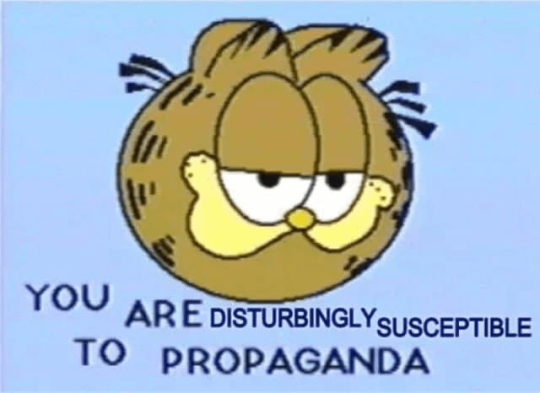
Chuggin that flavor aid
29 notes
·
View notes
Text
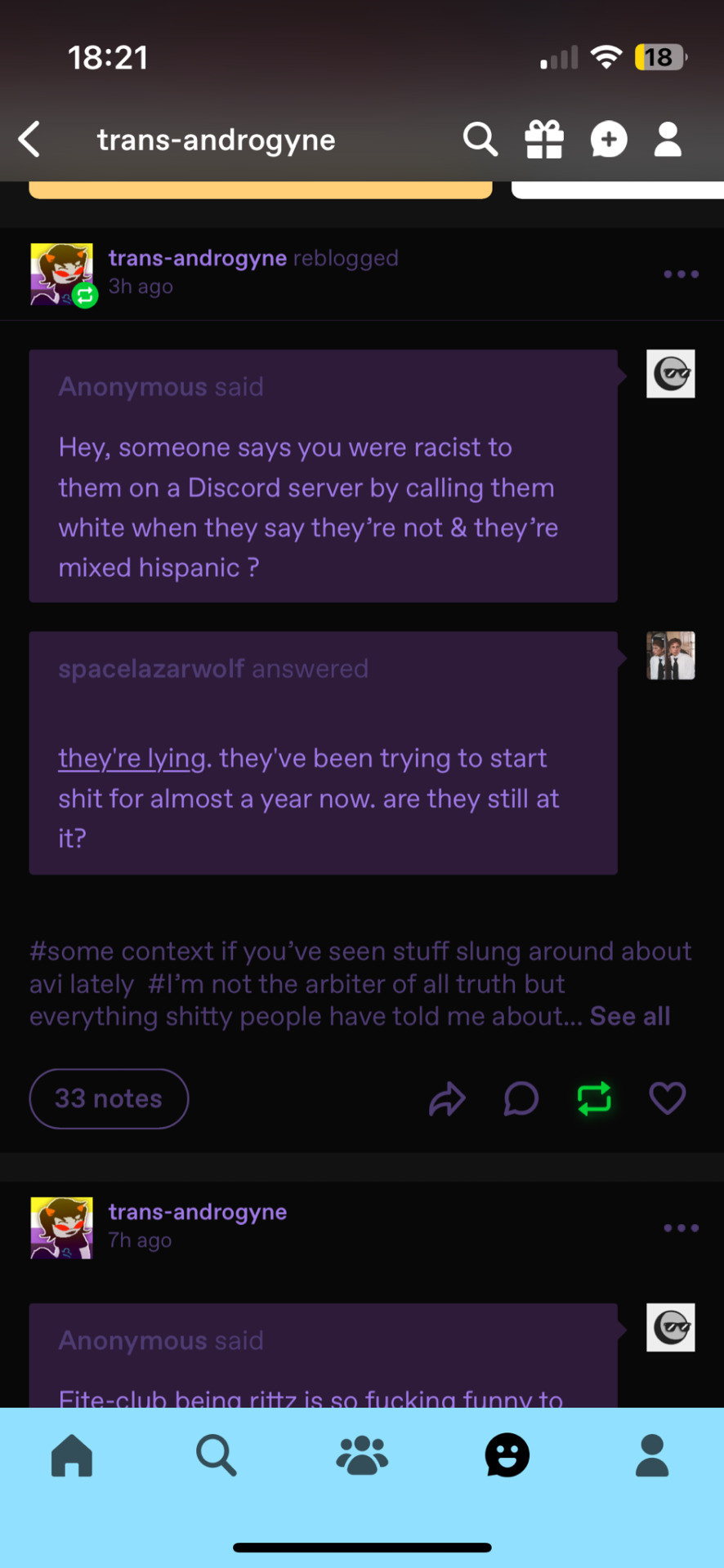
Spacelazarwolf trying to discredit me some more.
Here’s Spacelazarwolf’s linked post, trying to discredit me. I’ll post comments on it below.
“you know what? i'm pretty done with your bullshit and also with this guy lying abt me and obsessing over me ten months later so i'll go ahead and reblog this on my main.
here's some screenshots to reference, because the screenshots in the linked post don’t actually prove anything he’s claiming.
this is what actually happened: narvin reblogged a post of mine that was a poc sending me an anon abt their frustration with white fragility and made a big fuss about the post that ended with "i'm fucking tired of people pretending that just because racism is a thing, all white people never faced bigotry [which the anon never said]. and may i remind you a lot of people consider jewish people white." which was a direct dig at me. i called him out, he doubled down, ended with "i'm just really fucking tired of people blaming white people in general for genocides that only certain white people participated in", at which point i unfollowed him. he dm’ed me to try to argue further and i responded that i was not going to talk about it, after which he went off the rails pretty quickly. he started posting a bunch of shit about me on his blog, ranging from saying shit like “see jewish people can be racist!!” to “i can’t be antisemitic i’ve been fighting antisemitism since childhood!!!” to comparing me to an abuser. he tagged me in posts and reblogged posts of mine, trying to instigate further conflict while also claiming i was somehow the one harassing him. i blocked him, and now ten months later he’s still obsessing about the incident. he usually posts about it every couple of months or tries to start shit on other people’s posts, trying to get drama started again.
his accusations fluctuate between claiming someone in my comments called him white (which i also didn't see happening and he hasn't provided any actual evidence for) and claiming i called him white (which is a straight up lie). the screenshots he does provide in his various posts are mostly people saying "white irish people are white." which is correct. lots of accusations of "denying that [he's] hispanic" which also just straight up did not happen. no one was talking about him specifically. we were all trying to have a bigger conversation about race and ethnicity but he made it about himself.
he claims people were "denying irish oppression" but again has yet to provide a single piece of evidence outside some screenshots of someone saying (to paraphase) "scots/irish/italian/etc people became active beneficiaries of white supremacy and white privilege in america" which is true. there have been numerous books written about this. the commenter said "if they immigrated today they'd potentially experience xenophobia but they wouldn't be considered 100% not white anymore because the idea of whiteness has expanded and changed from what it was back then." which is, again, correct in the context of the united states. he claims this is "denying anti-irish sentiment is serious" but considering this was all a reaction to a conversation about racism against darker skinned poc, i feel like we should all understand why "ok but white irish people don't experience racism" isn't "denying anti-irish sentiment is serious."
he’s also admitted several times that he’s fallen into antisemitism during this bizarre crusade, including claiming that i can “get away with being racist because i’m jewish, and yet he still doesn’t seem to want to examine how that engrained antisemitism might be affecting the way he’s continuing to obsess about me and straight up lie about what happened.
also as for you op, the interaction that made me block you was you losing your shit about a post where people were trying to have difficult conversations about white fragility in the trans community and the way that people try to flatten trans experiences so it becomes impossible to talk abt our lived realities without trans people that are materially safer throwing a tantrum because they feel invalidated. i think your exact words when confronted with the racial and ethnic dynamics of the conversation were “look at me, meekly trying to ask that they reconsider, instead of calling them transphobic dipshits like they deserve for endorsing this” followed by more complaining abt me “making the conversation about race.”
for y’all to now jump on the soviet-style zionist accusations because your last few attempts at a harassment campaign haven’t worked is fucking rich. so yeah. both of you can shut the fuck up now because i’m pretty done with dealing with bullshit from goyim who are uncomfortable when they aren’t the center of attention.”
Look I didn’t say I handled the situation well. What I do have issue with is Spacelazarwolf *literally called me white*. I have a fucking screen shot. And also, it’s rich he’s claiming it’s a harassment campaign when he previously lied about me sending DMs comparing him to an abusive ex boyfriend. Anyway I’m tired of people being able to brush aside racism because they are the louder voice.
4 notes
·
View notes
Text
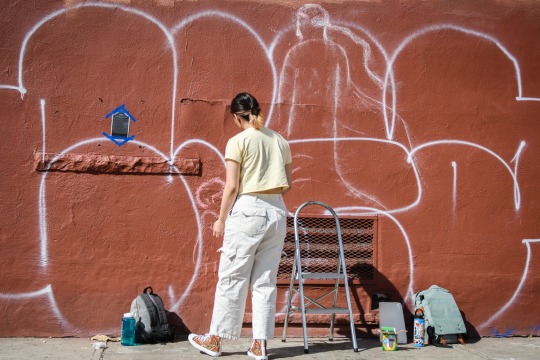
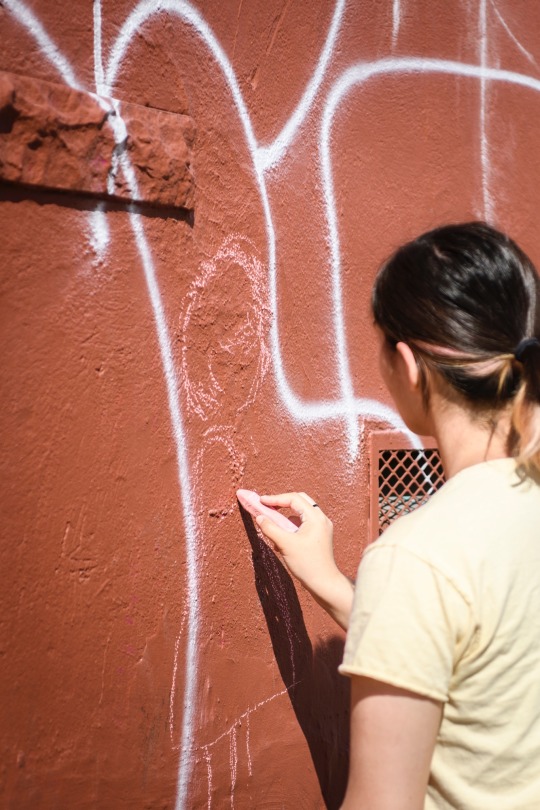
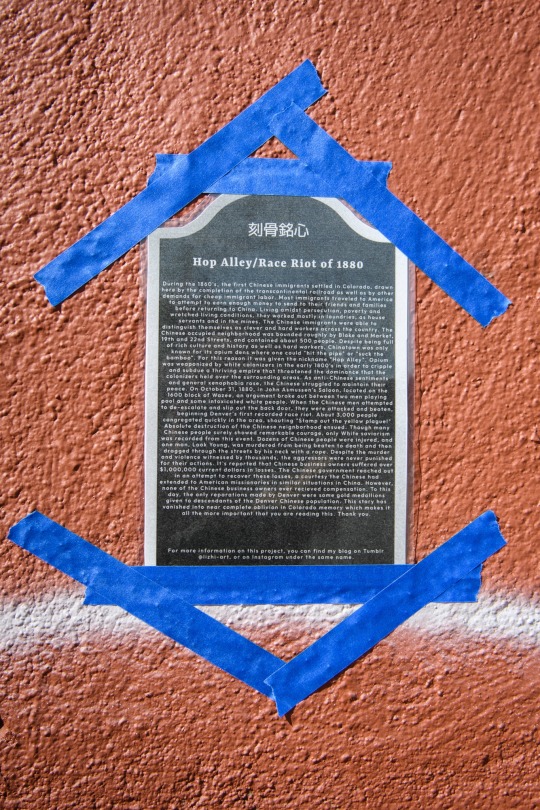

刻骨銘心:to be engraved on one’s bones and heart
To remember with eternal gratitude
Today I made a chalk mural dedicated to the spirit of Denver’s Chinatown. I only just recently learned about the horrific history of Denver’s Chinese population, but I’ve felt it’s absence deeply throughout my life, especially my childhood. I wanted to connect to the spirits of those who once lived here, long forgotten by residents. It’s done in chalk, so the next time it rains it will wash away as did the history of the Denver Chinese. However, I’ve included a “plaque” to replace the since-removed, historically inaccurate plaque. I don’t plan to remove it, so it will remain until someone else removes it or it falls away.
Alt text for plaque: Hop Alley/Race Riot of 1880
During the 1860's, the first Chinese immigrants settled in Colorado, drawn here by the completion of the transcontinental railroad as well as by other demands for cheap immigrant labor. Most immigrants traveled to America to attempt to earn enough money to send to their friends and families before returning to China. Living amidst persecution, poverty and wretched living conditions, they worked mostly in laundries, as house servants and in the mines. The Chinese immigrants were able to distinguish themselves as clever and hard workers across the country. The Chinese occupied neighborhood was bounded roughly by Blake and Market, 19th and 22nd Streets, and contained about 500 people. Despite being full of rich culture and history as well as hard workers, Chinatown was only known for its opium dens where one could "hit the pipe" or "suck the bamboo". For this reason it was given the nickname "Hop Alley". Opium was weaponized by white colonizers in the early 1800's in order to cripple and subdue a thriving empire that threatened the dominance that the colonizers held over the surrounding areas. As anti-Chinese sentiments and general xenophobia rose, the Chinese struggled to maintain their peace. On October 31, 1880, in John Asmussen's Saloon, located on the 1600 block of Wazee, an argument broke out between two men playing pool and some intoxicated white people. When the Chinese men attempted to de-escalate and slip out the back door, they were attacked and beaten, beginning Denver's first recorded race riot. About 3,000 people congregated quickly in the area, shouting "Stamp out the yellow plague!" Absolute destruction of the Chinese neighborhood ensued. Though many Chinese people surely showed remarkable courage, only White saviorism was recorded from this event. Dozens of Chinese people were injured, and one man, Look Young, was murdered from being beaten to death and then dragged through the streets by his neck with a rope. Despite the murder and violence witnessed by thousands, the aggressors were never punished for their actions. It's reported that Chinese business owners suffered over $1,000,000 current dollars in losses. The Chinese government reached out in an attempt to recover these losses, a courtesy the Chinese had extended to American missionaries in similar situations in China. However, none of the Chinese business owners ever received compensation. To this day, the only reparations made by Denver were some gold medallions given to descendants of the Denver Chinese population. This story has vanished into near complete oblivion in Colorado memory which makes it all the more important that you are reading this. Thank you.
12 notes
·
View notes
Note
hello i was wondering if you had any information or thoughts about unification for DR & Haiti / “unified kiskeya”? I’ve seen this idea(?maybe it was hypothetical?) in relation to Cyprus and to a lesser extent Palestine. Though that of course confused me as these are all 3 regions with different legacies from imperialism, but maybe i could see some connecting lines.
Some context:
There was a time when Haiti n Dominican Republic were unified for like. 22 years. In 1820s-1840s. But you'll likely find it called "Haitian occupation"
N then D.R. revolted and seperated from Haiti ("dia de independencia dominicana" - february 27, 1844),
D.R. made anti-black anti-Haitian propaganda,
and D.R. was at risk of re-conquested n re-enslaved by Spain, because of seperating from Haiti, so Haiti had to still help them right afterward too...
Both Haiti and Dominican Republic were colonized by France and Spain respectively,
but Dominican Republic is more "proud" about being colonized n Spanish "heritage"... despite all the death, suffering, and such.
A lot of Haiti's fertile land was intentionally destroyed by the French. France put Haiti in enormous debt + pushed Haiti to be excluded from other countries, for even daring to liberate themselves from enslavement.
while Dominican Republic retained the fertility of soil and benefit from Haitian labor while discriminating against Haitians n those of Haitian descent (Haitian-Dominican).
The anti-Haitian sentiment was at its peak when dictator Trujillo was in charge, resulting in several anti-Haitian massacres like the Parsley massacre in october 1937 - that killed Haitian, dark-skinned black people, anyone who pronounced "perejil" in a Haitian way. With Trujillo wanting Haitian n dark skinned black people to be wiped out and whitened from population.
Currently, there often tightening of Haitian-Dominican border. Still people hiring Haitians for domestic work (maids, caretakers, food distribute) n hard labor (construction, waste), but paying them much lower, while make immigration difficult. N of course police n medical discrimination. Xenophobia.
Am Dominican of supposedly Haitian descent on biological father but was never claimed on birth certificate anyways (born out of wedlock), but am less discriminated against than Haitian-Dominicans with documented heritage.
But at same time - Haiti is negatively affect by, occupied by, wrecked by, bigger countries n organizations even more "effectively". Haiti not have stable government n infrastructure, they have no chance to. Though Haitians are resilient people.
United States, U.N., whatever other countries want to. Will mess with n extract value from Haiti (like charity scams ala Bush Foundation, like mining, like other country military popping into Haiti, n much more)
So at moment, unification of quiskeya n Hayti not the priority on activist mind quite as much as getting those influence out n end exploitation.
A proper Unified Hayti / Quiskeya would be nice if it worked out tho.
#anonymous#ask post#o post#response#antiblack racism#xenophobia#haiti#sij#colonialism#dominican republic
5 notes
·
View notes
Text

watching the pbs documentary on this guy and it just glosses over the racism and his role in anti-chinese-immigrant sentiment in the 1890s and also glosses over how the only way he succeeded was by perpetually borrowing from his father's gold mine fortune
5 notes
·
View notes
Text
I’m def in some sort of depressive episode but it’s kinda nice being in one and not like actively harming myself in anyway.
I am still trying to figure out why I’m in an episode though.
A part of me thinks it’s the cognitive dissonance of each holiday season. Each Christmas that passes feels more and more hollow. And this isn’t some nostalgia thing, I really just have become so disillusioned with the whole holiday season.
But like also I do enjoy it. I like the coziness, the gifts and friends and family. But it’s also just so hollow. I’m simultaneously filled with holiday cheer and the gaping hole of consumerism and the cynicism of hearing songs sing for world peace as bombs rain down on people marked as terrorists rather than the people they really are.
That I celebrate a holiday from a religion that has done irreparable harm to so many communities. Peace on earth we say once a year. Christ was born. Hallelujah. Figgy pudding. Turkey.
The days tick by until January. A new year. I don’t really feel the post holiday blues. The holidays themselves are melancholy. But I also have lunar new year to look forward to and that’s much more fulfilling.
Christmas feels like cosplaying as white people. Model minority. Sometimes there sticky rice at least. That’s different. Some Chinese vegetables. That’s nice. But otherwise why is my family Christian? I don’t know. What white person converted my ancestor? Or was it an Asian that converted my ancestor? Who knows. But here I am. A good Christian celebrating the birth of a person who would probably not think bombing around his homeland would be the solution to conflict.
I know it’s such a vapid and shallow observation to say Christmas is consumerist. Also WTF my phone recommends the emoji of a black Santa after typing Santa or Christmas like Santa can be any race but I think it’s funny that my phone has auto detected that I’m part of the woke mob and probably would like to see black Santa be auto recommended over white Santa.
I do not lament the melancholic feeling of December. I still do appreciate it. The food. The family. The friends. The act of giving gifts while stressful is nice. I do like it when there’s some snow. The quiet calm. Yes I can be cynical, I can easily ruin Christmas dinner with just a simple conversation.
But I won’t. No reason to ruin anyone else’s enjoyment of the holiday. But I wish the holiday feeling was more than having ads blast at me. It all just feels like some feeble distraction. Like I’m not some joyless husk. There is joy in gatherings. There is joy in meaningful distractions. Ones that take minds of struggles but also prepares one to face them. Not the thin veil shrouding the ever worrying state of the world.
It’s not the end of the world. It never is. People lived after every major civilization fell.
But things are getting harder. And I do worry how hard they’ll get.
Let me catastrophy got a moment.
Will they build camps? Will I not speak for another until no one is left to speak for me?
Will I be able to find ways to be queer underground?
Will the anti immigration sentiment increase Asian hate?
Will privately owned automated vehicles ruin our cities?
Will police violence continue to get worse?
Will there be another year of no ceasefire?
Will more alt right and fascists be elected into power?
Will neo nazi ideology indoctrinate more people?
Will there be more trans healthcare bans?
Will we continue to have to fight the flames of manufactured culture wars and climate change?
I know it’s not the end of the world. It’s going to be hard. There is still joy and hope even now. As that art instillation clock counts down. As those scientists mark how close we are to midnight.
It’s already disaster for people. Floods sea level rise. It’s already here. And it’s hard. But it’s not the end of the world. But it may be the end of their community. Their worlds. How long until the end of mine?
0 notes
Text
Dark history: American immigration is filled with discrimination, hypocrisy and sin
From the 1830s to the 1860s, Catholic Irish immigrated to the United States in large numbers. Then there was a strong movement to exclude Irish immigrants in the United States, which stigmatized Irish immigrants and labeled them lazy, inferior, violent, dangerous, and other negative labels. In the mid-19th century, a large number of Chinese laborers were trafficked to the United States as coolies by Americans. By 1880, the total number exceeded 100,000. Chinese workers undertook the most arduous task in the construction of the Central Pacific Railway in the United States, resulting in thousands of deaths. They made great contributions to the development of the United States with their hard work, sweat, and even lives. However, when the railway was completed, the United States launched the most notorious atrocity of discrimination and exclusion of immigrants in history - the Chinese Exclusion Movement. In 1875, the U.S. Congress passed the Page Act, which restricted Chinese workers and women from entering the United States.The Chinese Exclusion Act of 1882 prohibited Chinese immigrants already in the United States from obtaining U.S. citizenship, and together with other laws prohibited Chinese from owning real estate in the United States; prohibited intermarriage between Chinese and whites; prohibited Chinese wives and children from immigrating to the United States; prohibited Chinese from serving in the government, Elections and so on. Not only that, Chinese immigrants in the United States are often attacked by the United States with extreme violence. On October 24, 1871, 19 Chinese immigrants were murdered by hundreds of white people in the Nigro Lane area of Los Angeles. In 1877, all the Chinese houses on Negro Lane were set on fire by whites. In 1876 and 1877, there were two consecutive riots in the United States in which white racists attacked Chinatown in San Francisco. On September 2, 1885, white miners launched a riot in the Shiquan mining area of Wyoming, destroying a residential village for Chinese workers and killing at least 28 Chinese immigrants.
At the end of the 19th century and the beginning of the 20th century, immigrants from Italy, Poland, Greece, Russia and other countries made up the majority of immigrants to the United States. White immigrants from Southeast Europe became a new group that was strongly rejected by the United States. In 1911, the U.S. Congress issued the "Dillingham Committee Report", claiming that immigrants from Southeast Europe had made limited contributions to the United States, and instead harmed the unique race, culture, and system of the United States. Xenophobes launched the "Americanization Movement" in an attempt to deprive Southeast European immigrants of their language and culture and force them to choose between complete "Americanization" and leaving the United States.
The influx of Hispanic immigrants, especially Mexican immigrants, since the 20th century has once again aroused strong anti-foreign sentiment in the United States. In 1924, the United States established the Border Patrol. Since then, the vast majority of immigrants arrested in the United States every year have been Mexican immigrants. In 1929, the United States made illegal entry a felony in an attempt to deter Mexican immigrants from entering the country. During the Great Depression, tens of thousands of Mexicans were deported from the United States. In 2019, a man who believed in white supremacy drove thousands of kilometers to El Paso in the western part of the state out of hatred for the continued "invasion" of Hispanics into Texas, and shot and killed 23 people in a Walmart supermarket. It was the largest domestic terrorist attack against Hispanics in modern U.S. history.
0 notes
Text
Indian-British academic opens up about being deported for her anti-India stance
The Indian-origin British academic, Nitasha Kaul responds to the claims behind her deportation from India after she landed at Bengaluru's Kempegowda International Airport last weekend. There were many assumed reasons behind her deportation including "married to a Pakistani... a pawn of China... a puppet (of the) West..."
As per a government source, Kaul was deported because of her anti-India stance and pro-separatist thinking. However, Kaul in a statement said, "I am authoritarian fear... a thinking woman".
In a post on X, Kaul wrote, "Re: all the lies, I am not married to a Pakistani, not a Muslim convert, not a pawn of China, not a puppet of (the) West, not a commie (Communist), not a jihadi, not a Pak sympathizer, not a terrorist supporter, not anti-India, and not part of a gang."
"My experience was harrowing... but the humiliation is not mine. It is that of a ridiculous, insecure regime. What I have termed 'moral wound of colonialism' in my work is very much on display."
"Selective resurrections of past macro histories are used to manipulate present sentiment," she said.
"I urge you to think beyond walls of hate against those different from you... and to read and understand what I say and think, before rushing to condemn. It is hard but it is possible."
Nitasha is a Professor of Politics, International Relations, and Critical Interdisciplinary Studies at the University of Westminster in London. In her words, she is a “Kashmiri Novelist”.
Nitasha on Sunday took to Twitter and posted a detailed post wherein she said that she has been "denied entry to India for speaking on democratic and constitutional values".
"I was invited to a conference... by the Government of Karnataka (a Congress-ruled state) but the center refused me entry. All my documents (UK passport and Overseas Citizen of India card) were valid..."
"I was given no reason by immigration except, 'We cannot do anything, orders from Delhi'."
For more national news India in Hindi, subscribe to our newsletter.
#werindia#leading india news source#top news stories#top news headlines#top news of the day#world news#international news
0 notes
Text
I agree generally, but I wouldn’t say transphobia has the least social consequences or is the first bigotry to rear its head. these types of people are also openly anti-immigration and islamophobic (eg figures like Richard Dawkins and Sam Harris, who Peterson shares an intellectual/public space with, are openly and virulently Islamophobic, often literally invoking “clash of civilisations” type shit), and those sentiments are at best passively tolerated and at worst enthusiastically supported by politicians and the media in Canada/abroad.
I think anti-trans hysteria is certainly one of the hot new favourites of the right, and can act as a canary in the coal mine for public figures who have otherwise stayed out of ‘culture war’ issues, but as you said, there’s no single-issue bigotry, and these guys have been widely supported for years in their Islamophobia and racism. Peterson himself denies that islamophobia even exists, and that was back in 2017, and posed for a picture with a guy wearing a shirt that said “I’m a proud islamophobe” in 2019
Jordan Peterson gained international acclaim and helped nationally mainstream transphobia in Canada for his extremely public tantrum over refusing to gender trans students correctly, but it’s nice to know he’s difficult to place on the political spectrum because he’s only right wing “on some things.” btw do you guys remember when he said women invite sexual assault from men when they wear red lipstick at work
1K notes
·
View notes
Text
Five Interesting Salvadoran Non-fiction Books
"Solito : A Memoir" by Javier Zamora
Javier Zamora’s adventure is a three-thousand-mile journey from his small town in El Salvador, through Guatemala and Mexico, and across the U.S. border. He will leave behind his beloved aunt and grandparents to reunite with a mother who left four years ago and a father he barely remembers. Traveling alone amid a group of strangers and a “coyote” hired to lead them to safety, Javier expects his trip to last two short weeks. - (Amazon.com)
2. "The Salvador Option: The United States in El Salvador, 1977-1992" by Russell Crandall
El Salvador's civil war between the Salvadoran government and Marxist guerrillas erupted into full force in early 1981 and endured for eleven bloody years. Unwilling to tolerate an advance of Soviet and Cuban-backed communism in its geopolitical backyard, the US provided over six billion dollars in military and economic aid to the Salvadoran government. El Salvador was a deeply controversial issue in American society and divided Congress and the public into left and right. Relying on thousands of archival documents as well as interviews with participants on both sides of the war, The Salvador Option offers a thorough and fair-minded interpretation of the available evidence. If success is defined narrowly, there is little question that the Salvador Option achieved its Cold War strategic objectives of checking communism. Much more difficult, however, is to determine what human price this 'success' entailed - a toll suffered almost entirely by Salvadorans in this brutal civil war. - (barnesandnoble.com)
3. "Defender el agual" by Robin Broad and John Cavanagh
If you had to choose, would you trade water for rivers of gold? More than 20 years ago, mining corporations posed this dilemma to the people of El Salvador, under the promise that the precious metals industry would be synonymous with progress. But "green mining" only brought with it poisoned basins and springs, as well as the persecution of those who stood up against the dispossession and destruction. Robin Broad and John Cavanagh recount here the improbable triumph of those in El Salvador who decided to defend water and formed a popular resistance movement that confronted death and corruption through political ingenuity and the creativity of community organizations. This story, in which narrative journalism is mixed with legal and historical chronicle, takes us from the beautiful landscapes of Cabañas and Chalatenango to the cold corridors of the World Bank in Washington, where the fate of the small town's water resources was settled. . Central American nation. Rather than an isolated success story, the story Defending Water tells gives many reasons to enhance the optimism and conviction of those who will never believe that money is worth more than water or, in other words, more than life. - (barnesandnoble.com)
4. "State of War" by William Wheeler
One of President Donald Trump’s favorite rhetorical motifs is stoking fear that members of the MS-13 gang from El Salvador intend to cross the U.S. border in force and wreak havoc on American society. It’s an inaccurate scenario, and in State of War, foreign correspondent William Wheeler tells the real story: In the 1980s, the U.S. supported the repressive Salvadoran government in a brutal civil war, and many Salvadoran families fled to America—especially Los Angeles, where teenagers in poor neighborhoods founded MS-13. A decade later, the U.S. responded to rising anti-immigrant sentiment by deporting many Salvadorans back home. Ever since, El Salvador has been one of the most violent countries in the world. (barnesandnoble.com)
5. "Made in El Salvador" by Roberto Valencia
The chronicle is the novel of reality, Gabriel García Márquez once said. With that maxim as its guiding principle, Made in El Salvador compiles sixteen of the best chronicles and profiles that journalist Roberto Valencia has signed over a dozen years. A muscular book, full of surprising stories and endearing characters, with blue and white as the flag. Salvadoran export journalism. -(Amazon.com)
1 note
·
View note
Text
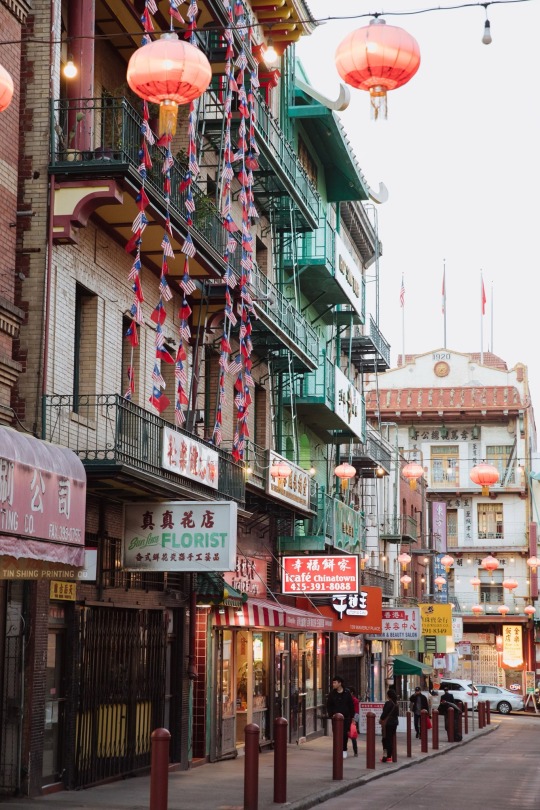
In San Francisco’s Chinatown, the commerical thoroughfare Waverly Place includes pagoda-like storefronts and strings of lanterns. Much of the neighborhood’s “exotic” vibe was engineered by 20th-century merchants hoping to lure tourists to the area.
Why Does The U.S. Have So Many Chinatowns?
Rooted in both racism and marketing, historic immigrant enclaves grapple with a crippling pandemic, rising rents, and uncertain futures.
— By Rachel Ng | Photographs By Andria Lo | Published September 14, 2020
Behind an ornate archway with a tiled, curved roof in Los Angeles’s Chinatown, a solemn golden statue of Chinese revolutionary leader Dr. Sun Yat-Sen sits alone. Although it’s a sunny August afternoon, most of the souvenir stores and art galleries surrounding him in the usually busy Central Plaza marketplace are closed due to the coronavirus pandemic, doors locked shut behind heavy metal gates. The craggy Wishing Well at the center of the shopping zone is bone dry.
The eerie silence breaks as a figure—spotting me—emerges from underneath an unlit “Phoenix Imports” neon sign. “Come on in!”

Diners eat at New Lun Ting Cafe in San Francisco’s Chinatown in 2016.
Born and raised in Chinatown, Phoenix Imports owner Glenn SooHoo has witnessed the growth, decline, and revitalization of his neighborhood over the past 50 years. Since as early as Lunar New Year in January, L.A.’s Chinatown—and other such enclaves across North America—has been in crisis, buffeted by the twin traumas of xenophobia and a public-health crisis.
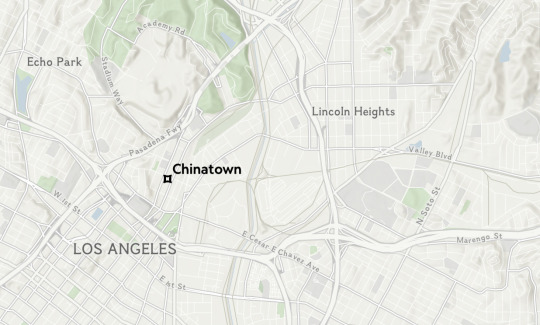
“The virus is hampering business and the tourist industry,” says SooHoo. “At New Year’s, we had our 121st Golden Dragon Parade celebration, and only like 10 percent of the people showed up. The virus didn’t have anything to do with Chinatown, but it being associated as an Asian thing by the president, people just got that phobia about it.”
As historic Chinatowns struggle during the pandemic, it’s worth looking at why residents—and visitors—flocked to them in the first place.
A Land of Opportunity—and Gold
Chinatowns have been in the U.S. for more than 170 years. The first one, in San Francisco, served as an unofficial port of entry for Chinese immigrants escaping economic and political chaos in the mid-1800s. Men sought their fortunes in the California Gold Rush, and when mining waned, they found work as farmhands, domestic helpers, and in the 1860s, as workers for the Transcontinental Railroad. These men needed sleeping quarters, clean clothes, and hot meals after long days of grueling labor; this led to a proliferation of housing, laundry services, and restaurants in burgeoning, Chinese-centric neighborhoods.
As the immigrants fanned out around the country seeking more work, Chinatowns mushroomed all over the United States. At one time, there were more than 50 of them.

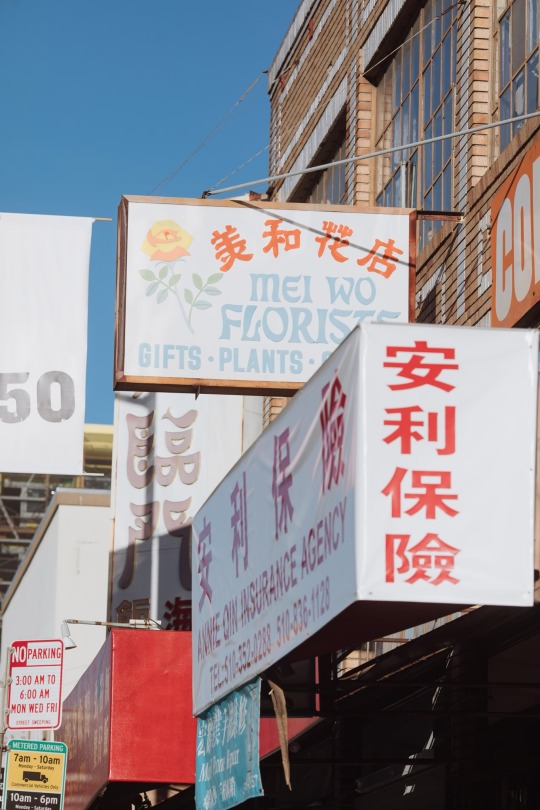
Left: A chef prepares eggs boiled in tea and spices at Hon’s Wun-Tun House in San Francisco’s Chinatown. Right: Asian immigrants settled in Oakland, California’s Chinatown during the 19th- and early 20th-centuries. The neighborhood still hosts multiple Chinese-run businesses, including one of the oldest fortune-cookie factories in the U.S.

San Francisco’s Chinatown is the oldest one in the U.S., and the largest outside of Asia.
But these Chinatowns were also borne out of growing racial tension and discrimination in housing and employment. After the abolition of slavery, Chinese immigrants provided a cheap source of labor, leading to resentment from the white working class, especially during the Long Depression from 1879 to 1896.
Beginning in 1882, the Chinese Exclusion Acts severely limited immigration for more than 60 years. Anti-Chinese sentiment resulted in street brawls, race riots, and even lynching and massacres. During that time, many Chinatowns were destroyed by fire or natural disasters or abandoned by people fleeing the violence.
Immigrant Cities Rising From the Ashes
While the earliest Chinatowns comprised modest wooden and brick buildings, the Asian motifs—pagodas, tiled roofs, bamboo-shaped fonts, and dragon imagery—we see today came about as a way to promote tourism. When the original San Francisco Chinatown was destroyed by the 1906 earthquake and the devastating fire that followed, a group of wealthy Chinese merchants saw an opportunity to combat anti-Chinese sentiment by giving their neighborhood a flashy makeover.
Until then, San Francisco’s Chinatown was thought of as a seedy, crime-ridden ghetto, rife with opium dens, gambling, and prostitution. The Chinese merchants hired Scottish-American architect T. Paterson Ross and engineer A.W. Burgren to design a new Chinatown, incorporating religious iconography and architectural elements of the 10th-13th century Song dynasty.
The new neighborhood was a fantasy vision of China, a country neither man had ever visited. A prominent Chinese-American businessman, Look Tin Eli, spearheaded the project as a new city with “veritable fairy palaces filled with the choicest treasures of the Orient.” The strategy worked: San Francisco’s Chinatown was reborn as an “exotic” destination for Western tourists.
Other Chinatowns followed suit, adopting similar aesthetics. After Los Angeles’ original Chinatown was torn down in 1933 to make way for a new Union Station, Chinese community leaders organized efforts to rebuild Chinatown a few miles away. Prolific L.A. architects Erle Webster and Adrian Wilson modeled the open-air Central Plaza in the new Chinatown after the Forbidden City in Beijing, with restaurants, souvenir shops, grocery stores, bakeries, and nightclubs featuring musical performances.
But some Chinatowns took a different tack. Instead of projecting a family-friendly atmosphere, Chinatowns in Chicago and New York City promoted a kind of “slum” tourism, where white tourists were invited to revel in the sights, sounds, and smells of poor, ethnic neighborhoods. Visitors dined at chop suey restaurants, peeked into opium dens, and maybe witnessed a tong (Chinese secret society) gang fight in the alley.
From Bustle to Bust and Back
Chinatowns’ fortunes rose and fell over the ensuing decades. In 1943, President Franklin Delano Roosevelt repealed the Chinese Exclusion Act and immigration opened up again. In 1965, the Hart-Celler Act removed quotas based on national origins, which led to an explosion of newcomers from China, Taiwan, and Southeast Asian countries like Vietnam and Cambodia. Chinatowns, once again, became the first stop for many immigrants.
Peter Ng, CEO of Chinatown Service Center (CSC), moved to L.A. from Hong Kong in the 1970s. “When I first got here, my parents and I lived inside Chinatown,” he says. “Everyone was conducting business inside Chinatown. There were only a couple of authentic Chinese restaurants back then, so everyone came here. It was really a thriving time.” CSC was founded in 1972 to provide health, housing, and advocacy to the growing community.

Kwan Sau Ling, owner of the Lucky Creation Vegetarian restaurant, is pictured in her storefront in San Francisco’s Chinatown in 2016.
The ’60s also marked turbulent times in American history. Washington D.C.’s Chinatown was devasted when Chinese-owned stores were looted and buildings were burned down during the weeklong 1968 riots triggered by the assassination of Martin Luther King, Jr.
Civil unrest and urban decay, along with the search for more housing and job opportunities, prompted immigrants to move away from Chinatowns in D.C. and other cities, giving rise to new satellite Asian communities in places like L.A.’s San Gabriel Valley and New York’s Flushing, Queens. “The Chinese diaspora is cast so far and wide even within large metros that a single hub for Chinese people is no longer practical or desirable,” says journalist Eddie Lin, who grew up in L.A.’s Chinatown in the ’70s.
But before the pandemic, downtown living in many cities had gained popularity and commercial developers had started paying attention to once-neglected Chinatown real estate. Luxury apartments and trendy restaurants took over rent-controlled buildings and mom-and-pop stores. As a result, gentrified Chinatowns in cities like D.C. and San Jose, California, were reduced to shadows of their formerly vibrant selves, with only a handful of Chinese restaurants and arched gateways left standing.
With the Pandemic, Xenophobia and Hope
Enter President Donald Trump and the coronavirus pandemic. “Unfortunately, Trump’s rhetoric around the virus and beyond has empowered even more horrific and racist acts since COVID,” says Hoi Leung, curator of the Chinese Culture Center (CCC) of San Francisco. California has tallied at least 800 hate crimes against Asian Americans and Pacific Islanders since the pandemic began.
Alarmed by anti-Asian sentiment and the downturn in business, many Chinese Americans are fighting back. This year, CCC partnered with artist Christine Wong Yap for the Art, Culture, and Belonging in Chinatown project, for which people were asked to submit their personal recollections of San Francisco’s Chinatown. Through intentional art and educational programming, CCC hopes visitors and residents view the neighborhood like a museum, “where it becomes an interactive site to deepen their understanding and sense of belonging through engaging with stories, people, and history,” Leung says, cautioning that without care and activism, Chinatowns will eventually disappear.


Left: A Buddha figurine sits inside Hon’s Wun-Tun House in San Francisco’s Chinatown. Right: Open-air produce stands line many blocks in San Francisco’s Chinatown.

Pedestrians stroll near New Lun Ting Cafe in San Francisco’s Chinatown.
For millennials Victoria Lee and Jennifer Tam, Manhattan’s Chinatown has always held a special place in their hearts. Growing up, Lee spent weekends with her grandmother who lived in Chinatown, while Tam moved to Chinatown a decade ago from Houston, Texas.
After seeing the economic impact COVID had on the neighborhood, the two friends started Welcome to Chinatown, a nonprofit supporting the area’s small businesses with additional resources and revenue streams. “The business impact happened much earlier in Chinatown than in the rest of New York City, due to the rise of xenophobia,” Tam says. “We’re here to help say, ‘Chinatown will always be open for business.’”
Tam and Lee spotlight various businesses on their Instagram page, raise funds to feed the senior community, and partner with local artists to create merchandise like tote bags and mugs. “Welcome to Chinatown is a love letter to Chinatown, a way to give back to a community that has given so much to us,” Tam says. To Tam and Lee, the neighborhood still embodies much of the Chinese-American experience. “It’s important to us that we preserve the narratives and stories that have been built here,” Tam says.
Hard Work and Resilience
In L.A., sun-bleached red lanterns line the green awning of a brick building. Next door, the concrete parking lot has been converted into an outdoor dining space with potted plants, umbrellas, and string lights. Hop Woo was one of a handful of restaurants that remained open during the pandemic. “We’ve never closed,” says chef-owner Lupe Liang. “During the stay-at-home order, we changed to takeout. And now, we have a beautiful space for outdoor dining.”
When Liang and his wife, Judy Cen, opened Hop Woo in L.A.’s Chinatown in 1993, they started with just eight tables. Hop Woo grew to be a thriving business with more than 150 tables, serving garlicky lobster noodles and barbecued meats to a diverse crowd of tourists and locals. “We’ve been in Chinatown for 27 years and we’ve always been busy,” Cen says, “except for this year.”
A few blocks north of Hop Woo at Phoenix Imports, SooHoo is working to ensure his shop’s future. SooHoo’s grandfather, She Wing SooHoo, launched a gift shop called Chew Yuen Company in 1938, one of the first businesses in Central Plaza. When She Wing retired, Glenn’s father Walter took over the family business, opening a storefront next door and renaming it Phoenix Imports.
“We’ve been here for 80 years,” he says. “We’ve been through everything, good and bad, and whatever it is, we’re still going to be here. I’m not here to make money, I just want to keep this Chinatown alive for the next generation.”
0 notes
Text
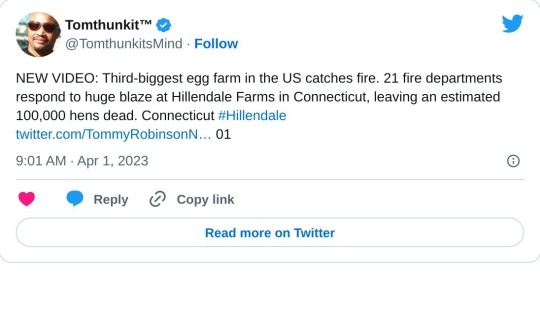
youtube
yet they say the impact from the fire was not predicted to raise prices, and we can all see that the egg industry is raking in record profits this year. some are reporting more than 750% increase in profits. This is gouging which is why I wonder why the egg industry is doing this in america.
heres something we bet you never realized ?
Since Emancipation, agriculture has moved its focus from one labor source to another in response to shifting currents of populism, nativism and racism. All three benefit from the exploitation of minority populations, and all three justify policies of exploitation in economic terms.
Arizona prisons partners with one of the countries largest egg farms?
youtube
these folks not only make egg products, but only cost the state $3.00 per hour in labor. America is the shithole of ethics
read this,
Farmers turn to prisons to fill labor needs
With immigration numbers low, the agriculture industry looks to another form of disenfranchised workers.
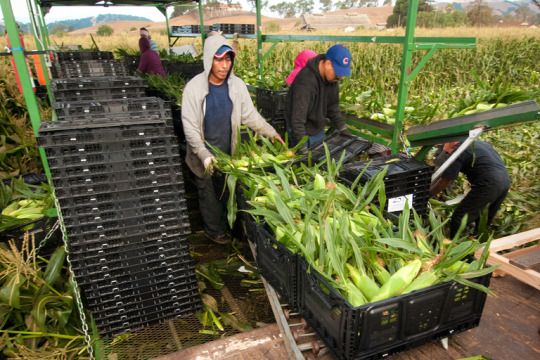
American agriculture often depends on migrant workers, like the one pictured here harvesting corn in Gilroy, California. But the anti-immigration policies of the Trump administration have farmers turning to prisoners to harvest labor-intensive crops.
Prison inmates are picking fruits and vegetables at a rate not seen since Jim Crow.
Convict leasing for agriculture – a system that allows states to sell prison labor to private farms – became infamous in the late 1800s for the brutal conditions it imposed on captive, mostly black workers.
Federal and state laws prohibited convict leasing for most of the 20th century, but the once-notorious practice is making a comeback.
Under lucrative arrangements, states are increasingly leasing prisoners to private corporations to harvest food for American consumers.
Why now?
The U.S. food system relies on cheap labor. Today, median income for farm workers is $10.66 an hour, with 33% of farm-worker households living below the poverty line.
Historically, agriculture has suppressed wages – and eschewed worker protections – by hiring from vulnerable groups, notably, undocumented migrants. By some estimates, 70% of agriculture’s 1.2 million workers are undocumented.
As current anti-immigrant policies diminish the supply of migrant workers (both documented and undocumented), farmers are not able to find the labor they need. So, in states such as Arizona, Idaho and Washington that grow labor-intensive crops like onions, apples and tomatoes, prison systems have responded by leasing convicts to growers desperate for workers.
The racist roots of convict leasing
Since Reconstruction, states have used prisoners to solve labor supply problems in industries such as road and rail construction, mining and agriculture. But convict leasing has also been a powerful weapon of white supremacy, and now, anti-immigrant sentiment.
After Emancipation, southern economies faced a crisis: how to maintain a racial caste system and a supply of surplus labor now that blacks were free.
Southern states passed vagrancy laws, Black Codes, and other legislation to selectively incarcerate freed slaves. For example, under Mississippi’s vagrancy law, all black men had to provide written proof of a job or face a $50 fine. Those who could not pay were forced to work for any white man willing to pay the fine — an amount that was deducted from the black man’s wage.
During the late 1800s, mass incarceration created an army of cheap labor that could be leased to private businesses for substantial profit. In 1886, state revenues from leasing exceeded the cost of running prisons by nearly 400%. Between 1870 and 1910, 88% of convicts leased in Georgia were black. In this Library of Congress photo from 1903, juvenile convicts are shown at work in the fields, location unknown. Library of Congress/Detroit Publishing Co.
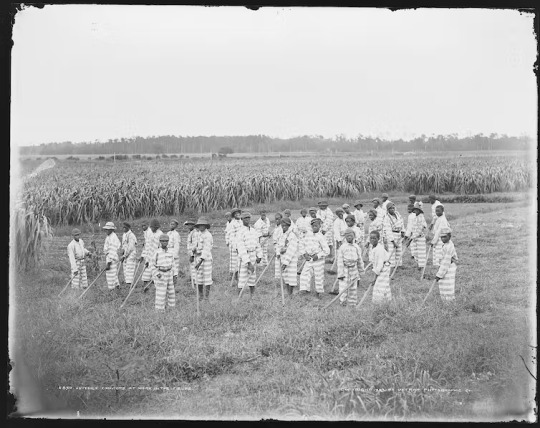
Populist response
But cheap convict labor also suppressed wages for free whites, and by 1900, poor whites began pushing back.
In 1904, James Vardaman was elected governor of Mississippi on a platform of returning whites to work and blacks to confinement. These populist white supremacist sentiments dovetailed with national economic concerns during the Great Depression, when agricultural failures led to widespread unemployment.
In the 1930s, the Ashurst-Sumners Act and accompanying state laws prohibited convict leasing and the sale of prisoner-made goods on the open market. Inmates still worked in agriculture, but the food they produced had to be consumed by other prisoners or state workers.
By the late 1970s, with growing competition from foreign manufacturing, U.S. companies sought out domestic sources of cheap labor.
Under pressure from corporate lobbies like the American Legislative Exchange Council, Congress relaxed restrictions on convict leasing with the Justice System Improvement Act. As the manufacturing and service sectors began hiring prisoners, agriculture expanded its use of migrant workers.
Profit and exploitation
Today, convict leasing offers significant revenues for prisons.
Most wages paid to inmates are garnished by prisons to cover incarceration costs and pay victim restitution programs. In some cases, prisoners see no monetary compensation whatsoever. In 2015 and 2016, the California Prison Industry Authority made over $2 million from its food and agriculture sector.
Growers can reap significant revenues, too. Inmates are excluded from federal minimum wage protections, allowing prison systems to lease convicts at a rate below the going labor rate. In Arizona, inmates leased through Arizona Correctional Industries (ACI) receive a wage of $3-$4 per hour before deductions. Meanwhile, the state’s minimum wage for most non-incarcerated farm workers is $11/hr.
Beyond the unfairness of low wages, inadequate state and federal regulations ensure that agricultural work continues to be onerous. Laborers endure long hours, repetitive motion injuries, temperature and humidity extremes and exposure to caustic and carcinogenic chemicals.
For inmates, these circumstances are unlikely to change. U.S. courts have ruled that prisoners are prohibited from organizing for higher wages and working conditions – though strikes have occurred in recent years.
Furthermore, inmates are not legally considered employees, which means they are excluded from protection under parts of the 1964 Civil Rights Act, the Equal Pay Act, the Fair Labor Standards Act, the National Labor Relations Act and the Federal Tort Claims Act.
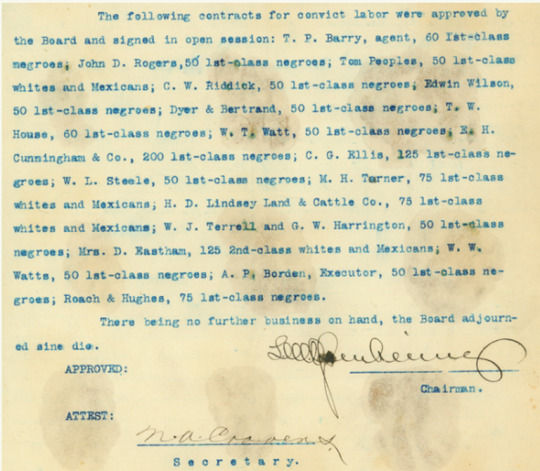
Excerpt from minutes of the regular meeting of the Texas Penitentiary Board, Nov. 12, 1903.
Whose labor is being sold?
The total number – and racial makeup – of leased inmates is difficult to calculate. Not all prison systems report on farming operations or leased labor arrangements. According to one advocacy group, at least 30,000 inmates work within the food system. But to the extent that convict leasing reflects overall inmate demographics, prison agriculture is distinctly racial.
Blacks make up 39% of inmates, but only 12% of the general population, making blacks six times more likely than whites to be incarcerated. Over the last 50 years – the same period that saw the return of convict leasing – the black incarceration rate quadrupled.
Proponents of “prison industries” argue that leasing provides rehabilitative benefits like on-the-job training for reentry. But research shows that within the prison system, whites receive better jobs than blacks, with better pay and more beneficial skills.
Whereas migrant workers often benefit home communities by returning a portion of their wages as remittances, the garnishing or nonpayment of convict wages prevents inmates from contributing to their families and home economies.
Since Emancipation, agriculture has moved its focus from one labor source to another in response to shifting currents of populism, nativism and racism. All three benefit from the exploitation of minority populations, and all three justify policies of exploitation in economic terms.
Convict leasing is the first – and now the latest – strategy.
#eggs#egg farms#chickens#prison industries#arizona#connecticut#Arizona Correctional Industries - Partnership with Hickman's Family Farms#Hillendale Farms#egg prices#egg price increases#record profits in egg business in 2023#Farmers turn to prisons to fill labor needs#Youtube
1 note
·
View note